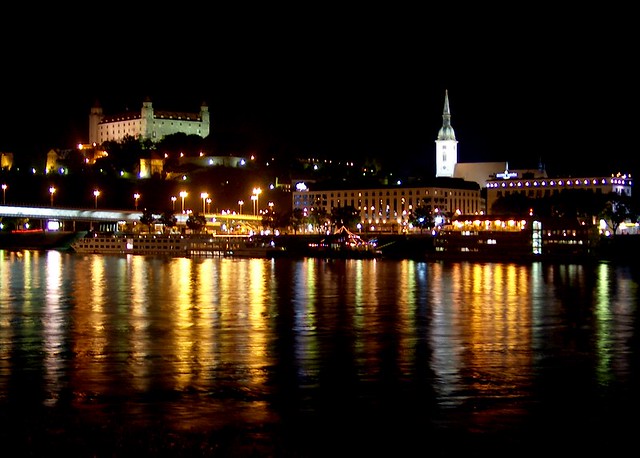Eastern Europe
Exploring the Hidden Europe in 2004 and 2008-2011
In 2004, I visited all 25 countries in Eastern Europe. You'll find the blog entries from that trip here. In 2008-2011, I returned to see what had changed since that time. With these two visits, five years apart, I accumulated enough material for my 750-page book, The Hidden Europe: What Eastern Europeans Can Teach Us.
This blog now has many excerpts from The Hidden Europe. But who the hell reads anymore? Just look at the best photos from Eastern Europe!
This map reflects how I define Eastern Europe. Eastern Europeans love to deny that they're in Eastern Europe. I tackle how and why I define Eastern Europe the way I do in the Introduction of The Hidden Europe.
Where to go in Slovenia
Places I saw and recommend in Slovenia: The Julian Alps (Triglav), the Soča River, its two best caves (Škocjan and Postojna), Ljubljana, the seaside (Piran/Izola/Koper).
Ljubljana: the lovely capital of Slovenia
Ljubljana (pronounced lyoo-blyah-nah) doesn't feel like a European capital. With only 272,000 residents, it's one of Europe's smallest capitals. Its downtown center is so compact that after walking a few blocks you're done. Although it's tiny compared to other capitals, the lovely Ljubljana lives up to its name. In Slovenian, ljubljena means beloved. Slovenians promote a similar play on words in English as they often write their country's name as Slovenia.
If Slovenia’s core is Ljubljana, and Ljubljana’s core is Prešernov Trg (Prešeren Square), then the core of Prešeren Square is truly the heart of the nation. So what’s at the core of Prešeren Square, symbolizing the very soul of Slovenia? A statue of an alcoholic.
Prešeren Square gets its name from Slovenia’s most famous drunk, who also wrote some profound poetry. Prešeren’s larger-than-life greenish statue looks longingly across the beautiful square at the home of the rich girl he wanted to hook up with. After years of trying to win her, he gave up, married another girl, had three children, had several affairs, drank like a fish, tried to commit suicide twice, and died confessing his unfulfilled love—he was 48. Decades after he died of liver disease, Slovenians dusted off his poems and said, “Hey, that loser actually wrote some pretty good shit!”
Today, Prešeren is Slovenia’s greatest poet. The Prešeren Award is Slovenia’s highest reward for artistic achievement. He’s on their two-euro coin. The day he died is a national holiday. His clever and epic poems united Slovenians after centuries of foreign rule. Most Slovenians can recite parts of his poems, especially “Zdravljica” (“Toast”), which the Austria-Hungary Empire banned. Today, it’s Slovenia’s national anthem.
Springing forth from Prešeren Square is the iconic and pedestrian-only Tromostovje (Triple Bridge), which spans the Ljubljanica River. The medieval Ljubljanski Grad (Ljubljana Castle) overlooks the city on a forested hill.
I spent the 2009 holidays in Ljubljana, Slovenia's cute capital.
Where to go in Hungary
Places I saw and recommend in Hungary: Budapest (especially the Széchenyi Medicinal Bath), Eger, Szeged, and Kecskemét.
Buda is posher than Pest. Buda has the impressive Castle Hill, luxurious housing, and grand buildings. It was the seat of royalty and the site of an ancient fortress. Today, tourists go there to enjoy the breathtaking view of the Danube River’s many bridges, the sharp spires of the Parliament, and the city lights of Pest. Although not as regal as Buda, Pest is where most of the action is. To get there, walk down the medieval cobblestones and cross Eastern Europe’s most beautiful bridge: Széchenyi Iánchíd (Chain Bridge). Or ride Europe’s second oldest underground subway.
Where to go in Slovakia
Places I saw and recommend in Slovakia: High Tatras, Bratislava, and Košice.

Bratislava
Bratislava is the best border town in the world. That's not saying much, since most border towns are as attractive as a fat, hairy man in a Speedo.
However, Bratislava is grand—it's one of the four elegant European capitals on the Danube River (the others are Vienna, Budapest, and Belgrade). From its outskirts, you can easily bike to Austria or Hungary.
Slovakia is such a mountainous country that Bratislava feels out of place, resting on a large, flat plain. Moreover, its rich, sophisticated architecture contrasts sharply with Slovakia's rustic mountain towns.
Founded in 907, Bratislava boomed under Austrian rule, and today it has about half a million residents.
After strolling through the pedestrian zone and admiring the Hodžovo nám (Center Square), you can check out the Bratislavký Hrad (Bratislava's castle) on the west side of the Danube.

Bratislava with some photoshopping.

This text is an excerpt from The Hidden Europe: What Eastern Europeans Can Teach Us. Listen to the podcast on Slovakia and read my 2004 blog post on Slovakia about stupidities in Slovakia.
- Czechia
- Eastern Germany
- Poland
- Belarus
- Lithuania
- Latvia
- Finland
- Counting to 10 in Estonian and four other languages
- Finland: home to the smartest kids in the world
- 10 facts about Estonia that you may not know
- Best photos
- Ahvenanmaa, but please call it Aland
- Tallinn, Estonia Tour - Bronze Soldier and Old Town
- The World's Most Dangerous and Extreme Backpacking
- Slovenia and Crveni Vrh, Croatia
- Western Russia
- Excitement in Estonia
- Anal Austrians
- Miseries in Minsk
- Bomb Damage in Bosnia-Hercegovina
Your comment will be deleted if:
- It doesn't add value. (So don't just say, "Nice post!")
- You use a fake name, like "Cheap Hotels."
- You embed a self-serving link in your comment.









